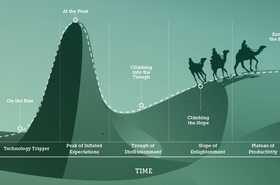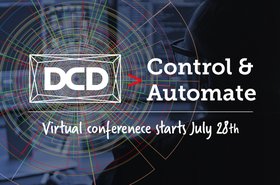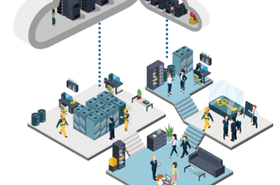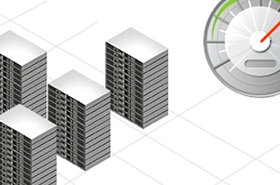Since the introduction of the Data Center Infrastructure Management (DCIM) concept to the general market by Gartner over a decade ago, the concept has struggled to mature. Worse than that, DCIM has become a term that is now considered tarnished by many following disappointing results from expensive DCIM deployments. Generally, DCIM has failed to deliver on the promises made and in many cases is merely a beefed up BMS or overpriced Asset Register! Nevertheless, experts are still predicting a 16 percent growth to 2024 with a forecast market value of over $3bn.
Data centers are designed, built and operated for one purpose alone, and that is to reliably and securely host the Compute, Storage and Network resources providing the digital services upon which we are all now so dependent in our daily lives. In this statement lies an irony though. Traditional facilities management teams continue to manage and maintain the building and the critical supporting infrastructure within it.
These elements provide the secure space and support the delivery of the critical power and cooling resources on which the installed IT equipment is totally dependent. These teams typically have no visibility of the hosted Information Technology equipment, or the expertise to understand the operation or management of this hosted equipment.
On the other hand, the Compute, Storage and Networking equipment in data centers tends to be looked after by traditional IT teams that have little understanding or interest in the critical infrastructure providing the power and cooling upon which their services depend.
It is often the case that extremely expensive and limited power and cooling resources are squandered, exposing their organizations to significant additional costs, potential Corporate Social Responsibility criticism due to environmental impact and the ongoing threat of Business Continuity issues when limited critical resources become depleted or unavailable.
This siloed approach to data center management has persisted for decades now and continues to be the commonly applied operational structure in most data centers. This despite repeated expert advice from across the sector strongly advocating improved operating models for over a decade.
The DCIM challenge
In this context a true DCIM system is essential to enable these suggested new operating models. However, the reality is that there can be no genuine DCIM system unless the gaps highlighted above are taken into account and the tools deployed include integration with the IT stack. Ultimately the IT load is the reason for a data center’s existence so a true DCIM needs to cover more than just the building infrastructure alone. Without this integration, the so-called DCIM solution will merely be an overly complex and therefore overly expensive Building Management System or an unnecessarily weighty asset register.
Moreover, the move towards distributed, digital infrastructures and hybrid environments is one of the most significant shifts in the data center sector, which potentially necessitates the overview and orchestration of infrastructure environments across multiple unmanned remote (Edge), sites. A true DCIM system needs to seamlessly integrate all elements of the data center into a single toolset that offers the required ‘Single Source of Truth’ view of multiple sites to all those responsible for data center operations and the reliable delivery of digital services.
One of the reasons that the siloed approach to data center management is still the most common operating model is the fact that until recently we have not had suitable tools that offer integration and visibility of both the IT equipment condition and the operation of the critical building infrastructure in a single system with a single view of the entire data center ecosystem. This also accounts for the continued dependency on the environmental envelopes defined by the IT equipment manufacturers via ASHRAE and within which ae are therefore required to design and build our data centers. From a cooling perspective, the front of the server is where these two separate worlds meet and handoff in a very segregated way. This should not be the case, the transition should be seamless. Nevertheless, this remains the prevailing highly inefficient method of managing data centers.
It is easy to forget that in a data center we are not trying to keep the servers at a specific temperature, we are actually trying to make sure that the chipsets within the servers are at an optimum temperature in order that they continue to function correctly. Not taking advantage of this information and relying blindly instead on the temperature at the front of the IT equipment is rather missing the point.
The same is true on the power side. Currently, the handoff between disciplines is typically at the cabinet/rack power supply or potentially (less commonly), at an intelligent power strip within the equipment rack/cabinet. Power usage monitoring is rarely performed on the basis of the power consumption information capable of being provided by the installed IT equipment itself.
It is manifestly obvious that any system claiming to be true DCIM tool which does not offer integration with and visibility of, the IT stack and the data that is readily available from that source is not really a DCIM system at all. It is at best merely a somewhat enhanced, data center specific BMS.
Real-time information from live systems is becoming increasingly available allowing real-time decision making and even control where appropriate. This can lead to a reduction in manual error-prone processes, a reduction in operational resources and access to far more accurate information. Because data is collected and stored in complex multi-layered and disparate systems though, gaining true value from this wealth of data requires the correct tools to be deployed using both greater integration and analytical techniques to take advantage of this information potential.
This data-centric approach paves the way for true automation, machine learning and ultimately AI in the data center (when AI becomes truly available beyond the dreams of marketing departments!). Automated provisioning is already possible with existing levels of real-time data from facility infrastructure to IT devices and even applications. Full stack integration is now available and is the key to both cost and operational efficiencies for a direct and tangible ROIs.
Aligning IT, Facilities, and other business stakeholders produces a competitive advantage and allows the transparency necessary to be able to properly manage distributed and hybrid architectures. Increasingly these will include both public and private Cloud deployments, legacy infrastructure and systems, as well as remote unmanned Edge installations.
Until very recently there were no tools available that could offer the full feature set of a true DCIM system. This is no longer the case. DCIM is now moving into the IT stack, as well as integrating with existing systems, such as ITAM, CMDB and cloud-based solutions. DCIM is now capable of offering the ability to analyze multiple data sets across sites and provide intelligent solutions for managing the data centre throughout the entire stack, from the BMS, to the IT equipment and through to application performance.
True DCIM needs to address the major challenges that IT and data center operators face today:
- Ability to reference, monitor, maintain and manage complex hybrid digital environments
- Support for Edge adoption and geographically remote ‘dark’ sites
- Integration with an increasing number of data sources and existing toolsets
- The capability for rapid, genuine integration at low cost in order to create a Single Source of Truth’ for all sites and all assets types within the entire data center stack (Both Facilities and IT)
- A need for improved capacity/resource planning and management, particularly for remote unmanned sites
- The ability to manage resources effectively. This should include traditional Space, Power and Cooling but also Compute, Storage, Bandwidth, Ports, Cabinets, Cabinet Us, Buildings, Energy, People, Cost etc.
- Automated provisioning based on company-specific rules and requirements with the generation of detailed work orders that can be used by 3rd party contractors without supervision
- The improvement of operational efficiency and cost reduction (Offering genuine ROI)
All the above capabilities must be provided while maintaining the core focus on Uptime, availability and time to service. It is also worth remembering that the ‘M’ in DCIM stands for Management not simply monitoring, which is all that many available solutions offer. Tools that do not have a genuine management capability do not satisfy the criteria required to be a true DCIM solution.
Where to next?
In the section above we have highlighted some of the reasons that DCIM systems have broadly speaking failed to deliver and developed a tarnished reputation despite the potential promise that they offer.
The reality is that until recently the functionality required simply did not exist. A true DCIM system is far more than a nice graphical interface for an asset management system or an expensive adjunct to a standard BMS system. Rather it is required to be a single toolset that monitors and allows management of all data centers resources in the context of the data center’s purpose, which again is to reliably host the IT equipment delivering digital services, This service delivery is critically dependent on the effective management of available capacity and the efficient consumption of limited and costly resources.
One of the key challenges in true DCIM implementation has been integration. This refers to both the discipline-specific tools deployed in a data center, as well as the operational process and procedures that allow effective day-to-day management and importantly when and how to automate. This integration is critical to effective management and historically has either been impossible or too technically or financially challenging to implement to the point that it has been actively discouraged. In addition, the increasing move towards distributed, digital infrastructures and hybrid environments has been one of the most significant shifts, which now necessitates the overview and orchestration of digital infrastructure and environments across multiples sites.
A true DCIM should be a single source of truth based on an integration ready approach offering the ability to share data across multiple disparate systems. This needs to be made available without the effort needed for integration being a barrier to rapid deployment and speed to use. An integrated approach should not aim to be all things to all people, however, but rather look to seamlessly hook into existing systems, taking advantage of those unique capabilities and data sets that may already be in place.
Historically this level of integrations has been technically impossible or too financially challenging, nevertheless the increasing shift towards distributed, digital infrastructures and hybrid environments requires an unambiguous overview and simplified orchestration of complex infrastructures across multiples sites.
In a world where IT systems are becoming more distributed, Edge deployment is increasing and IoT is making its mark, data center operators should be taking advantage of the data they are collecting by taking a data-centric approach to managing their sites, both local and remote. Siloed thinking and operational management no longer have a place in the modern data center: Facilities and IT managers need to work together, alongside a multitude of vendors who also need to align and integrate their offerings, sharing data to better accommodate their clients’ needs.
What is required are open integration capabilities that allow data center operators to pull their own bespoke solutions together, without racking up expensive development bills. It is now commonly accepted that the IT stack should be integrated into any genuine DCIM system and it should also connect to other business systems, such as CMDB, ERP and finance systems etc. It is also increasingly recognized that Facilities, IT and ‘the business’ frequently do not work well together or understand each other. The lack of integrated information and tools across multiple disciplines and sites remains a barrier to both cost and resource efficiency.
New DCIM solutions have recognized the shortfalls of previous generations of DCIM solutions and have implemented the required features described above. These features are the catalyst essential to getting all data center stakeholders to work together around core business processes that involve people, Facilities and IT infrastructure, as well as the assets and costly critical resources available across the data center ecosystem.







